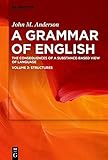A Grammar of English : The Consequences of a Substance-Based View of Language. Volume 2, Structures / John M. Anderson.
Material type: TextSeries: A Grammar of English ; Volume 2Publisher: Berlin ; Boston : De Gruyter Mouton, [2022]Copyright date: ©2022Description: 1 online resource (XXI, 638 p.)Content type:
TextSeries: A Grammar of English ; Volume 2Publisher: Berlin ; Boston : De Gruyter Mouton, [2022]Copyright date: ©2022Description: 1 online resource (XXI, 638 p.)Content type: - 9783110730920
- 9783110729566
- 9783110729504
- 428.2
- PE1106 .A47 2022
- PE1106 .A532 2022
- online - DeGruyter
- Issued also in print.
| Item type | Current library | Call number | URL | Status | Notes | Barcode | |
|---|---|---|---|---|---|---|---|
 eBook
eBook
|
Biblioteca "Angelicum" Pont. Univ. S.Tommaso d'Aquino Nuvola online | online - DeGruyter (Browse shelf(Opens below)) | Online access | Not for loan (Accesso limitato) | Accesso per gli utenti autorizzati / Access for authorized users | (dgr)9783110729504 |
Browsing Biblioteca "Angelicum" Pont. Univ. S.Tommaso d'Aquino shelves, Shelving location: Nuvola online Close shelf browser (Hides shelf browser)
Frontmatter -- Contents -- Parts I and II are available in A Grammar of English. Volume 1: Categories -- Preface -- Part III: Lexicon -- Prelude to Part III: Formatives, words, compounds, and phrases -- Chapter 27 Derivational Morphology and Morphosyntax -- Chapter 28 Word Accent, Morphophonology, and Phonology -- Chapter 29 Inflectional Morphology and Functional Categories -- Chapter 30 Compounds and Affixes -- Chapter 31 Sourceless Compounds -- Chapter 32 Lexical Phrases, and Localism -- Chapter 33 Icon and Metaphor -- Chapter 34 Figurativeness -- Conclusion to Part III -- Part IV: Syntax -- Prelude -- Fit the 1st: Finites -- Chapter 35 Mood, Existence, Negation, and Scope -- Chapter 36 Subject-Selection, Notional Weakening, and Grammatical Periphrases 10.1515/9783110729504-013 -- Chapter 37 Subordinate Finites -- Fit the 2nd: Non-Finites -- Chapter 38 Gerunds and Participles -- Chapter 39 Infinitives -- Fit the 3rd: Placement, Alt-Placement, and Sub-Placement -- Chapter 40 The Syntax of Determiners -- Chapter 41 Co-indices: Mobility and Ellipsis -- Chapter 42 Co-indices and Pre-utterance Phonology -- Envoi -- Subplot: Commentary on the Text -- References
restricted access online access with authorization star
http://purl.org/coar/access_right/c_16ec
This grammar of English embraces major lexical, phonological, syntactic structures and interfaces. It is based on the substantive assumption: that the categories and structures at all levels represent mental substance, conceptual and/or perceptual. The adequacy of this assumption in expressing linguistic generalizations is tested. The lexicon is seen as central to the grammar; it contains signs with conceptual, or content, poles, minimally words, and perceptual, and expression, poles, segments. Both words and segments are differentiated by substance-based features. They determine the erection of syntactic and phonological structures at the interfaces from lexicon. The valencies of words, the identification of their semantically determined complements and modifiers, control the erection of syntactic structures in the form of dependency relations. However, the features of different segment types determines their placement in the syllable, or as prosodies. Despite this discrepancy, dependency and linearization are two of the analogical properties displayed by lexical, syntactic and phonological structure. Analogies among parts of the grammar are another consequence of substantiveness, as is the presence of figurativeness and iconicity.
Issued also in print.
Mode of access: Internet via World Wide Web.
In English.
Description based on online resource; title from PDF title page (publisher's Web site, viewed 25. Jun 2024)









